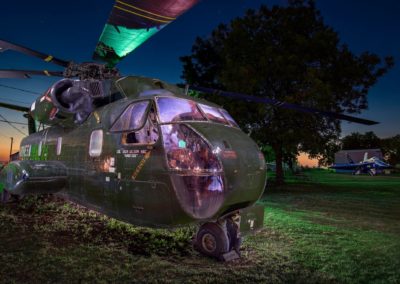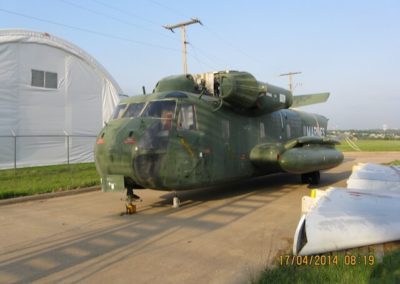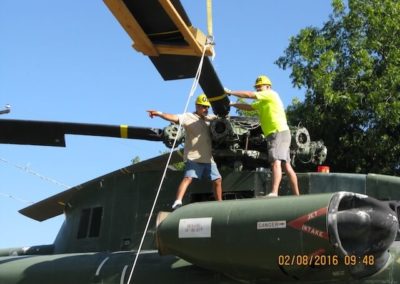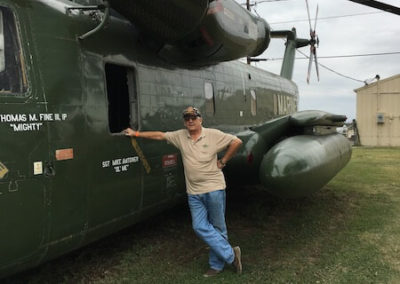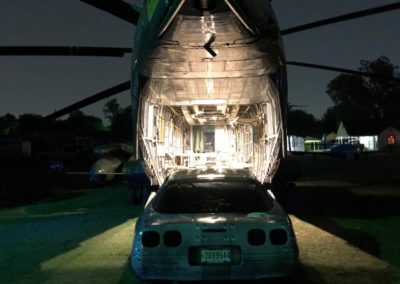CH-53 Sea Stallion
The CH-53 Sea Stallion is the common name for the Sikorsky S-65 family of heavy-lift transport helicopters. These were originally developed for use by the Marine Corps as they sought a replacement for the piston powered helicopters in 1960.
Warbird Overview
The CH-53 Sea Stallion is the common name for the Sikorsky S-65 family of heavy-lift transport helicopters. These were originally developed for use by the Marine Corps as they sought a replacement for the piston powered helicopters in 1960.
In March 1962, the US Navy’s Bureau of Naval Weapons, acting on behalf of the Marines, issued a request for a Heavy Helicopter Experimental or HHX. The specifications dictated a load capability of 8,000 pounds with an operational radius of 100 nautical miles at a speed of 170 mph. The goal was for an aircraft to for assault transport, aircraft recovery, personnel transport, and medical evacuation roles. Sikorsky won the contract in July 1962.
ABOUT THE A-12 AVENGER II
The CH-53 Sea Stallion is the common name for the Sikorsky S-65 family of heavy-lift transport helicopters. These were originally developed for use by the Marine Corps as they sought a replacement for the piston powered helicopters in 1960.
In March 1962, the US Navy’s Bureau of Naval Weapons, acting on behalf of the Marines, issued a request for a Heavy Helicopter Experimental or HHX. The specifications dictated a load capability of 8,000 pounds with an operational radius of 100 nautical miles at a speed of 170 mph. The goal was for an aircraft to for assault transport, aircraft recovery, personnel transport, and medical evacuation roles. Sikorsky won the contract in July 1962.
The first YCH-53A prototype flew on 14 October 1964 production CH-53s began in 1966. The first CH-53A arrived in Vietnam in January 1967. A total of 141 CH-53As were built, including two prototypes. The Navy used a version of the helicopter along with the Air Force who ordered the HH-53B in September 1966. The Air Force called theirs “Jolly Green Giants.” The Marines order a more powerful version – the CH-53D – in 1969. Two of these served as Presidential, VIP transports.
Versions of the CH-53 were also acquired by Germany, Iran, Israel, and Mexico. Although similar in appearances, a CH-53E Super Stallion with a third engine was introduced in 1980. In 2007, the Marines began replacing some CH-53s with MV-22B Ospreys. The plans are to replace the CH-46Es and CH-53Ds, but not their CH-53Es. A new and improved CH-53 is in the works – the CH-53K — for Navy and Marine Corps capabilities.
Fact #1
Lorem ipsum dolor sit amet, consectetur adipiscing elit, sed do eiusmod tempor incididunt ut labore et dolore magna aliqua. Ut enim ad minim veniam, quis nostrud exercitation ullamco laboris nisi ut aliquip ex ea commodo consequat.
Fact #2
Lorem ipsum dolor sit amet, consectetur adipiscing elit, sed do eiusmod tempor incididunt ut labore et dolore magna aliqua. Ut enim ad minim veniam, quis nostrud exercitation ullamco laboris nisi ut aliquip ex ea commodo consequat.
Fact #3
Lorem ipsum dolor sit amet, consectetur adipiscing elit, sed do eiusmod tempor incididunt ut labore et dolore magna aliqua. Ut enim ad minim veniam, quis nostrud exercitation ullamco laboris nisi ut aliquip ex ea commodo consequat.
Manufacturer: Sikorsky
Length: 88 feet 6 inches
Width: 28 feet 4 inches (stub wings), 15 feet 6 inches (fuselage only)
Height: 24 feet 11 inches or 16 feet 7 inches
Rotor: Six blades, 72 feet in diameter
Empty Weight: 20,950 pounds
Gross Weight: 33,484 pounds
Useful load: 8,000 pounds
Max Take-Off Weight: 42,000 pounds
Power Plant: Two 2,850 horsepower General Electric T64-GE-6 shaft-turbine engines
Maximum Speed: 195 mph, Cruise at 173 mph
Service Ceiling: 16,700 ft.
Range: 280 miles
Crew: Two pilots and a crew chief with provisions for 38-55 troops, 24 stretchers, vehicles, or artillery pieces
Our CH-53 was originally constructed by Sikorsky Aircraft in Stratford, Connecticut in 1967. It was accepted by the Naval Plant Representative Office (NAVPRO) on June 29, 1967. It was assigned Navy Bureau of Aeronautics Number 153715 and was Sikorsky Serial Number 65-105. The aircraft is a wounded, Vietnam Veteran and was used to trained countless Marines in its later training role.
The aircraft was first assigned to Marine Heavy Helicopter Squadron FOUR SIX TWO, HMH-462, “Heavy Haulers” in September 1967. It carried the aircraft number YF-#? (RESEARCHING). The Heavy Haulers were part of Marine Air Group FIVE SIX (MAG-56) at Marine Corps Air Facility Santa Ana, California.”
The aircraft arrived in Vietnam during 1968 and was assigned to Headquarters and Maintenance Squadron SIXTEEN, H&MS-16, Marine Air Group SIXTEEN (MAG-16), at Marble Mountain Air Facility near Da Nang. This assignment ran from May until June 1968.
From June 1968 until September 1969, the helicopter was assigned to Marine Heavy Helicopter Squadron FOUR SIX THREE, HMH-463, “Pegasus” which was also part of MAG-16 at Marble Mountain. It carried the aircraft number YH-#?.
During its period of service, which included resupplying Marine base camps and other transport missions, the aircraft was on the receiving end of periodic enemy rocket attacks launched against its base of operations. During one such attack in 1968-1969, the helicopter was peppered by shrapnel from a near miss. Repairs applied to the holes in the airframe are still readily visible and are responsible for the helicopters nickname “Patches.” The name was painted in red forward of the starboard hatch.
From September 1969 until July 1971, it was assigned to and operated by H&MS 56 COSA, MAG-56 at HMH-361, California. In July 1971, H&MS 56 was redesignated H&MS 16. In October 1971, the helicopter was assigned to Marine Heavy Helicopter Squadron THREE SIX ONE, HMH-361, “Flying Tigers” at Santa Ana, California. It carried the aircraft number YN-#?.
From September 1974 until May 1980, the helicopter was in deep preservation at Military Aircraft Storage and Disposal Center (MASDC) at Davis-Monthan AFB in Tucson, Arizona. It was assigned MASDC number 2J0024 in October 1974.
In May 1980, the helicopter was removed from storage and sent to the Naval Air Technical Training Center Millington (NATTC Millington) in Memphis, Tennessee. The helicopter became a training aid in the Basic Helicopter Maintenance School. It was during this time that the left-hand “D” sponson was installed with a 650-gallon drop tank thus becoming a CH-53D.
The helicopter remained at Millington until 1997 when it was transferred to the National Naval Aviation Museum in Pensacola, Florida, for outdoor display (Museum Accession Number 1996.388.001, date 30/09/1996). The Fort Worth Aviation Museum acquired the helicopter in 2013 on loan from the National Naval Aviation Museum (NNAM).
Good shape and is in original paint. Washing is all it needs, and she is good to go. No major repairs just some panels being worked on to stabilize.
Note: Scheduling is always a moving target depending on weather and workload. All schedules are subject to changes.
Become a Member!
FLIGHT SIMULATOR
Events
Movie Night At the Museum – The A-Team
Lorem ipsum dolor sit amet, consectetur adipiscing elit, sed do eiusmod tempor incididunt ut labore et dolore magna aliqua.
September 11th @ 8PM to 9PM
Movie Night At the Museum – The A-Team
Lorem ipsum dolor sit amet, consectetur adipiscing elit, sed do eiusmod tempor incididunt ut labore et dolore magna aliqua.
September 11th @ 8PM to 9PM
Movie Night At the Museum – The A-Team
Lorem ipsum dolor sit amet, consectetur adipiscing elit, sed do eiusmod tempor incididunt ut labore et dolore magna aliqua.
September 11th @ 8PM to 9PM
Movie Night At the Museum – The A-Team
Lorem ipsum dolor sit amet, consectetur adipiscing elit, sed do eiusmod tempor incididunt ut labore et dolore magna aliqua.
September 11th @ 8PM to 9PM
HOURS
Saturday: 9AM-2PM
Sunday: 11AM-3PM
